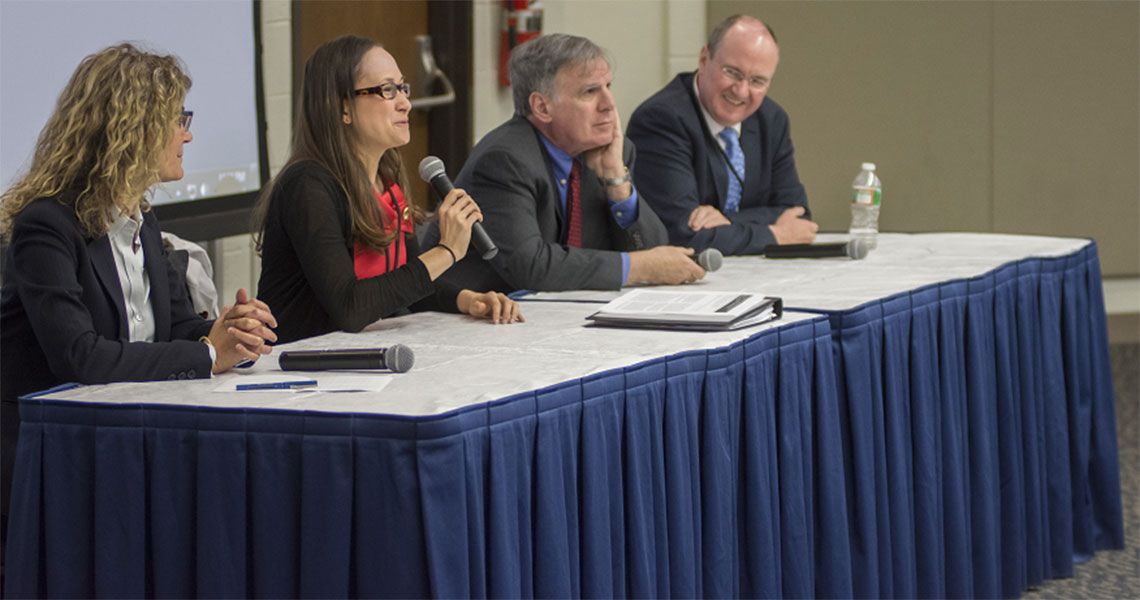Gary Simon invoked the words of Donald Rumsfeld in describing the Zika virus at a town hall held Feb. 12 for GW students, faculty and staff. “The problem is, we don’t know what we don’t know,” said Simon, M.D., Ph.D., Walter G. Ross Professor of Medicine and director of the Division of Infectious Diseases at the GW School of Medicine and Health Sciences (SMHS). "We're really going to have to investigate."
Simon, along with moderator Lawrence “Bopper” Deyton, M.D. ’85, M.S.P.H., senior associate dean for clinical public health at SMHS, and his fellow panelists — Douglas Nixon, M.D., Ph.D., Walter G. Ross Professor of Basic Science Research and chair and professor in the Department of Microbiology, Immunology, and Tropical Medicine at SMHS; Aileen Chang, M.D., M.S.P.H., assistant professor of medicine at SMHS; and Huda Ayas, Ed.D. ’06, M.B.A. ’98, M.H.S.A. ’93, associate dean for international medicine and executive director of the Office of International Medicine Programs (IMP) at SMHS — told those in attendance what they do know.
The evolution of the Zika virus, according to Nixon, traces back nearly 70 years to the Ugandan Zika forest, a swath of tropical plants that borders Lake Victoria. The forest, home to several dozen species of mosquitoes, was fertile ground for yellow fever researchers in the mid-1940s; in 1947, however, scientists isolated the Zika virus — a member of the Flavivirus and related to yellow fever, dengue, and chikungunya — from a rhesus monkey. Four years later, scientists isolated the virus in a human volunteer, but it appeared “as a mild illness,” Nixon said. In 2007, the first documented outbreak appeared in the Yap Islands in Micronesia; by 2015, the epidemic had reached 33 countries and regions.
The virus, according to Nixon and Chang, is spread by Aedes mosquitoes, notable for white stripes on their legs. This particular species is an aggressive daytime biter, found in temperate environments with stagnant water. Previously, the virus wasn’t known to cause serious human disease, and even now, only one in five people infected with the virus will display symptoms — fever, rash, joint and muscle pain, headache, and conjunctivitis — which last for about a week. Because the clinical burden of Zika-caused illness was so minor in the past, no vaccine or specific treatments have been developed; physicians can only treat the symptoms. Nixon and Chang were quick to reassure, though, that living conditions in North America, versus those of parts of South America, may help protect the population against an epidemic of any infection carried by Aedes mosquitoes.
“When people talk about the likelihood that we’re going to have an enormous outbreak in the U.S., one thing [to keep in mind] is most people in the U.S. have access to air-conditioning,” Chang said. “Most people in the U.S. have screens on their windows. Most people in the U.S. also have access to repellant, and it’s not too expensive. It’s very different, the risk for transmission locally, as opposed to these other [South American] countries.”
Brazil and Colombia, the researchers said, have had the largest numbers of documented Zika infections, and Brazil currently has one of the highest rates of a birth defect associated with the Zika virus: microcephaly, a condition in which a baby is born with an abnormally small head and potential brain damage.
“It can be pretty devastating diagnosis,” Nixon said.
The Zika virus has also been linked to Guillain-Barré Syndrome, a rare autoimmune disorder of the central nervous system. Simon was quick to point out that there is no known direct cause between the Zika virus and the two conditions right now, though testing is ongoing. The World Health Organization (WHO), the Centers for Disease Control and Prevention (CDC), and several countries have advised pregnant women to consider postponing travel to countries where Zika virus transmission is now documented.
SMHS is encouraging pregnant students or students planning on pregnancy to speak with a physician before traveling abroad, Ayas added. Student travel isn’t banned, but GW is monitoring current information from CDC and WHO for updates about the Zika virus, and IMP is in communication with students already out of the country. In fact, Ayas said, many of GW’s medical students are looking at Zika as a learning and research opportunity. It’s an attitude in line with the experts’ at the town hall held Friday and at a second town hall Feb. 23, which also featured Homa Ahmadzia, M.D. ’08, M.P.H. ’08, assistant professor of obstetrics and gynecology at SMHS.
“[With] any public health/population health issue of importance, we’re going to have to learn about the science of what we knew before, what we know now, and what’s new: its applications to basic science, to research, to clinical, and to prevention,” said Deyton.



